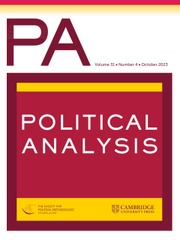No CrossRef data available.
Article contents
Estimating the Local Average Treatment Effect Without the Exclusion Restriction
Published online by Cambridge University Press: 21 July 2025
Abstract
Existing approaches to conducting inference about the Local Average Treatment Effect or LATE require assumptions that are considered tenuous in many applied settings. In particular, Instrumental Variable techniques require monotonicity and the exclusion restriction while principal score methods rest on some form of the principal ignorability assumption. This paper provides new results showing that an estimator within the class of principal score methods allows conservative inference about the LATE without invoking such assumptions. I term this estimator the Compliance Probability Weighting estimator and show that, under very mild assumptions, it provides an asymptotically conservative estimator for the LATE. I apply this estimator to a recent survey experiment and provide evidence of a stronger effect for the subset of compliers than the original authors had uncovered.
Information
- Type
- Article
- Information
- Copyright
- © The Author(s), 2025. Published by Cambridge University Press on behalf of The Society for Political Methodology
Footnotes
Edited by: Jeff Gill

